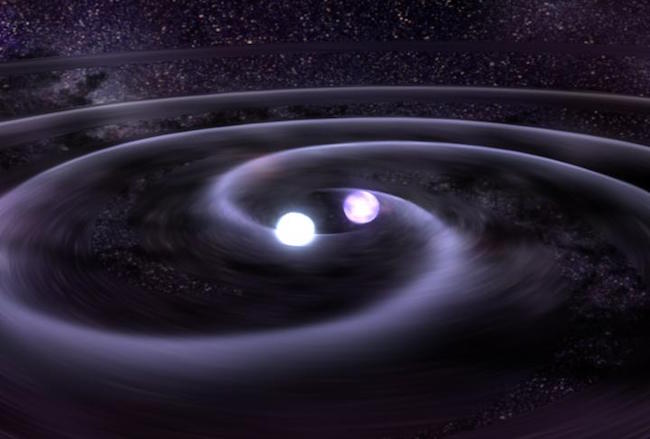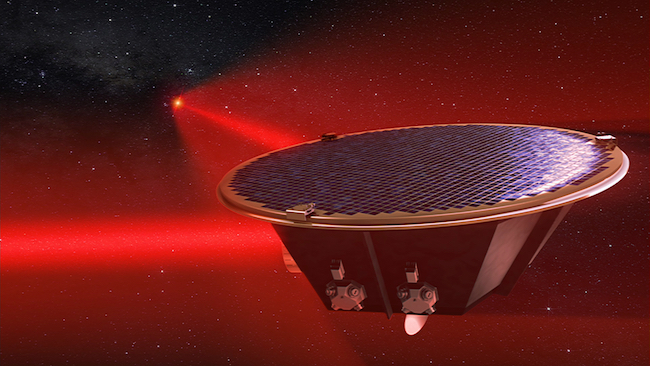Gravitational Waves
Gravitational Waves
One way to describe gravitational waves is as "ripples in space-time." They were predicted a century ago by Einstein's Theory of General Relativity. His theory describes how space-time is affected by mass. We can think of space-time as a fabric that bends or curves when we place an object on it. (Of course, space is actually 3-dimensional, plus the added dimension of time.)
Imagine pulling a sheet tight between several people and placing a bowling ball in the center of it. The mass of the ball would cause the sheet to curve. The curve is weak far away from the ball, and steeper near the ball. In fact, the sheet is a bit stretched in the area near the ball, as well. This is analogous to the curvature of space-time in the presence of mass. Near a mass, space-time curves more drastically and stretches. Near a very large mass, the 'dent' in space-time is very deep.

Illustration of how space-time curves in the presence of a massive object – in this case, the Earth. (Credit: NASA's Imagine the Universe)
To take the analogy of the sheet one step further, imagine that you had two bowling balls on the sheet, and they were orbiting each other's common center of mass. This would cause ripples in the sheet to move from the bowling balls outward. In space-time, these are the ripples we would call gravitational waves, and they travel at the speed of light.
Where Do Gravitational Waves Come From?
Gravitational waves are produced by masses moving through space-time in a special way. The simplest system that produces gravitational waves is two masses orbiting their common center of mass.
One of the most common such system is a binary star system – two stars orbiting each other's common center of mass. It turns out that about half of the stars you see in the sky are members of a binary system. And those stars can be at any stage of their life cycle, which means you can have any combination of a normal star, giant star, white dwarf, neutron star, or black hole. Another place you might find large masses orbiting each other is the center of a galaxy - if two galaxies merged, their central supermassive black holes would orbit for a long time before they also merged.

Artist's impression a neutron star merger and the gravitational waves it creates. (Credit: NASA/Goddard Space Flight Center)
As the black holes, stars, or galaxies orbit each other, they send out waves of "gravitational radiation" that travel at the speed of light. The waves that reach us are extremely weak because, like water waves, gravitational waves decrease in strength as they move outward. Despite being weak, the waves can travel unobstructed within the 'fabric' of space-time, providing us with information that light cannot.
How Can We Detect Gravitational Waves?
The detection of gravitational waves requires measurements that detect changes in distance less than the size of an atomic nucleus - that's tiny! To do this, scientists use interferometry, which consists of two parts: test masses separated by a distance and lasers to measure that distance.
Test masses are set at a large distance from each other – the large distance helps make any change in their distance be large enough to measure. The masses are then shielded from all disturbances except gravity, which we cannot shield against.
Then lasers make continuous measurements of the distance between each of the test masses. The masses are free to move in response to gravity so that when a gravitational wave passes, space-time stretches and the time it takes light to travel between the masses changes.
Gravitational waves were first detected by the ground-based LIGO detectors in 2015 using ground-based facilities in Washington and Louisiana. The Virgo detector in Italy spied its first gravitational wave in 2017. A space-based observatory called LISA is scheduled to launch in the early 2030s as part of the European Space Agency's Cosmic Visions Program.

Artist's impression of a Laser Interferometer Space Antenna (LISA) mission concept spacecraft. LISA is a space-based observatory of gravitational waves consisting of a constellation of three spacecraft, with launch planned for 2034. It is the third large mission (L3) in ESA's Cosmic Vision plan. (Copyright: AEI/Milde Marketing/Exozet)
What Will We Learn From the Detectors?
Gravitational waves are helping physicists and astronomers to understand some of the most fundamental laws of physics. They tell us about the dynamics of large-scale events in the universe like the formation and growth of galaxies and the supermassive black holes at their centers. With LISA, scientists will be able to probe through space and time, to observe the universe just a fraction of a second after the Big Bang. Using this information, we may be able to learn more about how the universe began and evolved.
Text updated: October 2017

